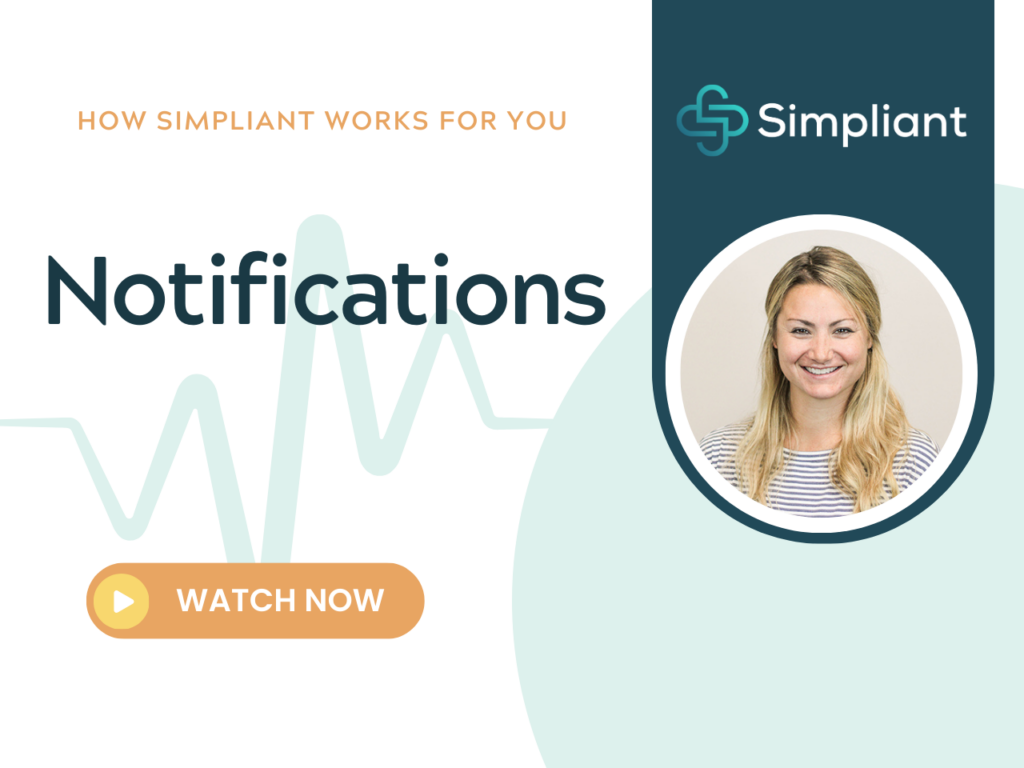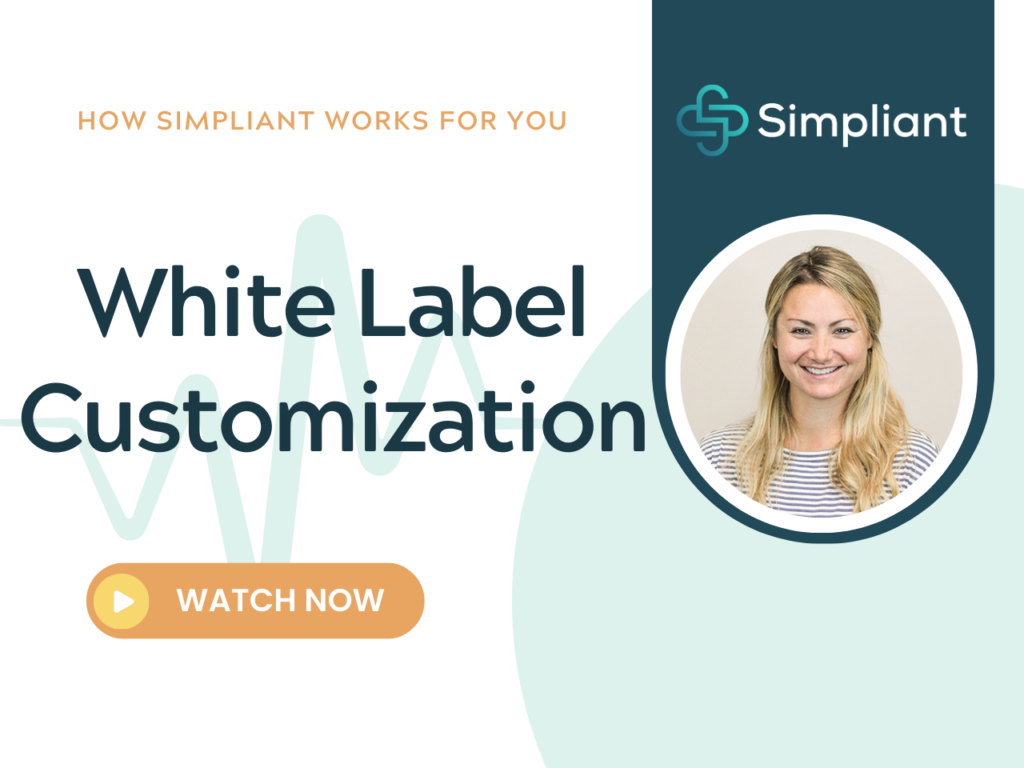Simpliant’s dashboard has a brand new look with 8 interactive widgets. Customize your (home page) to easily access information about either candidates, calendar, placements, job reqs, pending approvals, offers, upcoming expires and compliance.
Category: Product Features

Dashboard

Notifications
In Simpliant, receive only the notifications that are relevant to you. Tired of constant and unnecessary notifications cluttering your inbox? Select which notifications you need and easily turn off the rest!

Hospital Staff Before Contingent Labor: Leveraging Internal Mobility for Efficient Operations
The Covid 19 pandemic exposed and magnified an already fragile healthcare labor market. Once the dust settled, hospitals once again found themselves trying to improve their staffing workflows. There is no simple or single answer to the problem, and the situation must be solved while hospitals continue to fight a constant battle to meet patient needs while managing resources effectively. As demands shift and evolve, many facilities look towards contingent labor for quick fixes. But what if there was another solution hiding right under their noses? Enter internal mobility—a powerful strategy that leverages existing staff to fill gaps and enhance operations. Not only does this approach foster a more engaged workforce, but it also leads to improved patient care outcomes.
The Power of Internal Mobility
Internal mobility is a term used to describe a more fluid staffing model that enables hospitals to expand the skills and talents of their current workforce enabling a more fluid and flexible internal workforce. This approach encourages staff to explore different roles within the organization, fostering a culture of growth and development.
When employees feel valued and see opportunities for advancement, they are more likely to stay engaged. This not only boosts morale but also reduces turnover rates—a critical factor in maintaining continuity of care for patients.
Moreover, leveraging existing talent can lead to quicker and cost-effective onboarding processes. When internal candidates transition to new roles, they already understand the organizational culture and procedures. This inherent familiarity streamlines operations and enhances team dynamics.
Emphasizing internal mobility creates an adaptable workforce, ready to respond swiftly during times of increased patient demand or staffing shortages. The ripple effect positively impacts both employee satisfaction and overall hospital efficiency.
Getting Started
As with any long-term complex issue, there isn’t a simple fix, and hospital leadership might not see improvement or benefit for months, or even years, after implementing a staffing strategy that empowers staff to improve and diversify their skills to improve the opportunities available to them. When employees can shift roles, they often feel more satisfied and engaged in their work. This flexibility promotes career growth and skill development.
Finding the right technology that will integrate with current scheduling and HRIS tools to identify vacant shifts and the right people to fill them can be challenging. Most hospitals achieving success in building an internal mobility program have opted to treat this pool as an additional layer of workers who receive priority in filling vacant shifts and are incentivized above current external pools or travel staff when distributing jobs. Simpliant has created a seamless way to not only recognize holes in the schedule, but a way to distribute them to an internal pool first via a robust yet simple workforce portal.
Moreover, internal mobility reduces the disruptive impacts of hiring contingent labor. Staff who know the organization well can adapt quickly and maintain operational continuity during staffing shortages.
All these factors contribute to a healthier workplace culture, benefiting everyone involved—staff members thrive while providing better service for patients seeking comfort and support during difficult times.
A Win-Win Strategy
Harnessing the potential of internal mobility creates a symbiotic relationship between healthcare organizations and their staff. By prioritizing the development and movement of current employees, hospitals can optimize their workforce without relying heavily on contingent labor.
This strategy not only fills staffing gaps quickly but also fosters a culture of loyalty among employees. When staff members see opportunities for growth within their organization, they are more likely to stay engaged and committed to patient care. This reduces turnover rates, a significant challenge in healthcare staffing.
Moreover, patients benefit from continuity of care as familiar faces attend to their needs. A stable workforce leads to improved patient outcomes and satisfaction levels, ultimately enhancing the reputation of the facility.
Embracing this win-win approach positions healthcare facilities not just as employers but as nurturing environments where both patients and professionals thrive together.

Healthcare Leaders Get Creative Filling Staffing Needs
The healthcare industry is experiencing a decades-long staffing crisis, and healthcare leaders are stepping up to find innovative solutions to address this challenge. The COVID-19 pandemic only worsened an already dire situation, with some estimates approaching 100,000 nurses leaving the profession during the pandemic due primarily to stress and burnout. To make matters worse, an estimated 900,000 nurses intend to leave the workforce entirely by 2027. This mass departure of experienced professionals poses a significant problem for the healthcare industry, leading to a decline in the quality of patient care and increased workload for the remaining staff. To tackle this crisis, healthcare leaders are now thinking outside the box to fill these short and long-term vacancies.
Recruitment initiatives are accelerating, with a focus on attracting new talent to the industry. Now more than ever, healthcare facilities are partnering with educational institutions to offer scholarships and internships to students interested in healthcare careers. By exposing more individuals to the possibilities in nursing and allied health, these initiatives not only help fill immediate vacancies but also ensure a steady influx of new talent into the industry.
Like recruitment, another strategy that can have an immediate impact is investing in training and development to upskill existing staff. Although not a new concept, hospitals are breaking down duties and responsibilities across units and facilities to make sure they’re optimizing all current staff to provide some relief to the specialties stressed most by the shortage. By providing opportunities for growth and advancement, healthcare facilities can ensure they have a highly skilled team ready to step up when needed. This not only helps to address vacancies but also enhances the quality of patient care.
One approach is redefining job roles and expectations. By offering flexible working hours and job-sharing opportunities, healthcare leaders can appeal to a broader range of potential employees. This not only helps to fill staffing gaps but also promotes work-life balance, reducing burnout among healthcare professionals. There are many technologies available today to assist a facility in managing the flexible workforce. We’re excited to have a front row seat as the modern mobile and web applications improve access to jobs for nurses, and better ways to distribute vacant shifts and long-term orders to qualified nurses while consolidating vendor panels, credential management, and billing.
Technology is also playing a crucial role in mitigating staffing shortages. Workforce management technologies like Simpliant and various HRIS, as well as telehealth services, have seen a significant utilization increase during the pandemic. These technologies enable healthcare facilities to optimize their workforce and provide remote care, bridging the gap caused by staffing shortages. An integration and eventual consolidation of these systems will continue to increase efficiencies.
The healthcare staffing crisis is a complex issue with no quick fixes as the shortage is fighting a two-front war- attrition and lack of new nurses. By thinking creatively and adopting innovative approaches, healthcare leaders can begin to address these challenges. Unfortunately, there isn’t an easy road ahead, and the problem can seem overwhelming. But small steps lead to bigger ones; by offering flexibility, investing in training, leveraging technology, and ramping up recruitment efforts, the industry can recover from the pandemic’s impact and ensure high-quality patient care moving forward.

White Label Customization
Keep your brand front and center while leveraging the robustness of Simpliant’s cloud-based VMS. By using your colors and logo in the application, Simpliant gives your program the freedom to differentiate your brand from the competition by seamlessly integrating into your user experience. Another example of technology driving service, not the other way around.

Agnostic Technology
Whether you’re an acute or post-acute care provider, finding the right combination of staffing service and technology solutions can make all the difference in streamlining operations and maximizing efficiency, ultimately leading to improved patient care and internal employee satisfaction and retention. In a constantly evolving industry, agnostic technologies haven’t been the choice since agencies purchased most of the leading neutral VMS technologies 10-15 years ago. Since then, many of the top 20 agencies have followed the industry agency leaders by purchasing or building VMS technologies to support their vendor-led programs. There are advantages and disadvantages to both systems, but the emerging neutral VMS stands out as a game-changer, offering flexibility and transparency like never before. Let’s dive into how agnostic technology is shaping the future of healthcare staffing.
Neutral vs. Vendor Owned
In the realm of healthcare staffing technology, the debate between neutral and vendor-owned platforms is ongoing. Neutral agnostic technology operates independently, free from bias towards specific vendors or agencies. This neutrality allows for a more comprehensive view of available opportunities and resources. That said, MSP and hospital-managed programs can implement a good neutral VMS as they see fit; they can optimize their strongest supplier partners at the geographic, facility, or even unit level, rewarding the best vendor by giving them prioritized access to jobs. Alternatively, they can review their vendor panels regularly; moving vendors in and out of the top tier, which motivates the supplier to provide the best staff as quickly as possible at a competitive bill rate.
On the other hand, vendor-owned platforms may prioritize their own interests, potentially limiting access to certain job orders, or prioritizing their staff in the submission process. Simple economics would suggest that a vendor-led program might not be ideal, but in a difficult market, a loyal and attentive vendor who knows and understands the client best will prioritize their clients over third-party relationships, thus ensuring that the client maintains a high level of service and satisfactory fill rates.
Ultimately, the choice between neutral and vendor-owned technology comes down to transparency and fairness in job order distribution. Agnostic platforms offer a level playing field for all stakeholders in the supplier panel.
Fill Rate Transparency
Fill rate transparency plays a crucial role in ensuring a program has the information necessary to reward the best performers on their supplier panel. That visibility includes, but isn’t limited to time to submit, time to fill, on time starts, bill rate, and extensions awarded. Understanding these metrics and acting on them ensures the MSP or hospital is partnering with the best suppliers in their market, as agency performance can improve but also decline based on factors that the hospital or MSP might not have access to.
Having transparent fill rates allows healthcare facilities to track how effectively their job orders are being fulfilled, but they can also provide insights into areas that may need improvement, such as optimizing recruitment strategies, or adjusting internal processes.
By partnering with an agnostic technology platform that offers real-time data on fill rates, healthcare organizations can make informed decisions and better manage their staffing needs. Transparency fosters trust between all parties involved and promotes collaboration for achieving common goals.
Vendor Panel Depth
Many vendors don’t participate in the programs of their competitors. This isn’t an issue in a down market when one vendor-led MSP can fill most of their client needs, but when demand increases and stresses the candidate pool, having access to nurses from every vendor is beneficial. Additionally, just because your vendor-led program excels at filling nursing positions, an upswing in allied health or a particular specialty might leave the client without access to staff from a leading competitor of their vendor-led MSP partner. With agnostic technology, the MSP or health system can intelligently flex to give access to and prioritize job orders to suppliers best suited to fulfill those needs.
By utilizing algorithms and data analytics, agnostic technology ensures that critical positions are filled promptly while also considering the specific needs of each healthcare facility. This level of customization leads to better outcomes for both clients and candidates alike. In our fast-paced industry, using technology to quickly recognize a gap in the supply chain and filling it with the best vendor partner can make all the difference in keeping regular full-time staff content and attentive to the most important customer- the patient.
In summary, making an informed decision about your labor program can be challenging. Every agency, neutral MSP, vendor-led, and neutral VMS will attempt to influence that decision with data, technology full of bells and whistles, and the sometimes, flashy presentation performance. Only the client can decide what program works best for them. If you’re a multi-state system with hundreds of millions or even a few billion in contingent labor spend, the decision is easier as every supplier, MSP, and tech will do back flips to earn your business. Unfortunately, the other 90 percent isn’t so fortunate, and until recently, struggled for the last decade to build a program or find a partner where they could confidently state that they were getting the best staff from the best agency partners at the best rates. If you’re in that boat, an agnostic platform managed internally or by a neutral MSP will give you the best opportunity to reach what once seemed unattainable – an equitable, transparent, and thus satisfactory labor program.

